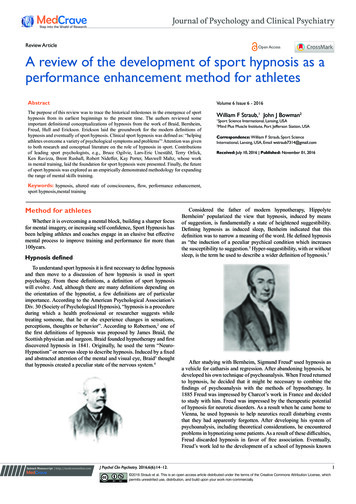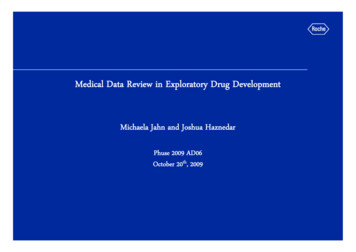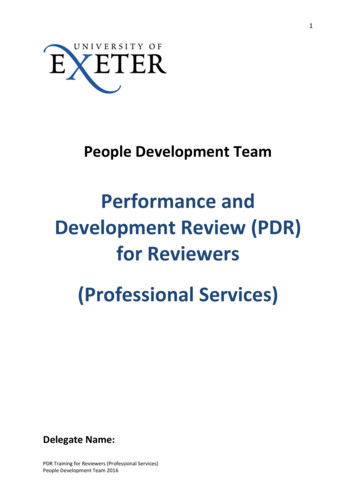
Transcription
Journal of Psychology and Clinical PsychiatryReview ArticleOpen AccessA review of the development of sport hypnosis as aperformance enhancement method for athletesAbstractVolume 6 Issue 6 - 2016The purpose of this review was to trace the historical milestones in the emergence of sporthypnosis from its earliest beginnings to the present time. The authors reviewed someimportant definitional conceptualizations of hypnosis from the work of Braid, Bernheim,Freud, Hull and Erickson. Erickson laid the groundwork for the modern definitions ofhypnosis and eventually of sport hypnosis. Clinical sport hypnosis was defined as: “helpingathletes overcome a variety of psychological symptoms and problems”1 Attention was givento both research and conceptual literature on the role of hypnosis in sport. Contributionsof leading sport psychologists, e.g., Bruce Ogilvie, Lars-Eric Uneståhl, Terry Orlick,Ken Ravizza, Brent Rushall, Robert Nideffer, Kay Porter, Maxwell Maltz, whose workin mental training, laid the foundation for sport hypnosis were presented. Finally, the futureof sport hypnosis was explored as an empirically demonstrated methodology for expandingthe range of mental skills training.William F Straub,1 John J Bowman2Sport Science International, Lansing, USAMind Plus Muscle Institute, Port Jefferson Station, USA12Correspondence: William F Straub, Sport ScienceInternational, Lansing, USA, EmailReceived: July 10, 2016 Published: November 01, 2016Keywords: hypnosis, altered state of consciousness, flow, performance enhancement,sport hypnosis,mental trainingMethod for athletesWhether it is overcoming a mental block, building a sharper focusfor mental imagery, or increasing self-confidence, Sport Hypnosis hasbeen helping athletes and coaches engage in an elusive but effectivemental process to improve training and performance for more than100years.Hypnosis definedTo understand sport hypnosis it is first necessary to define hypnosisand then move to a discussion of how hypnosis is used in sportpsychology. From these definitions, a definition of sport hypnosiswill evolve. And, although there are many definitions depending onthe orientation of the hypnotist, a few definitions are of particularimportance. According to the American Psychological Association’sDiv. 30 (Society of Psychological Hypnosis), “hypnosis is a procedureduring which a health professional or researcher suggests whiletreating someone, that he or she experience changes in sensations,perceptions, thoughts or behavior”. According to Robertson,2 one ofthe first definitions of hypnosis was proposed by James Braid, theScottish physician and surgeon. Braid founded hypnotherapy and firstdiscovered hypnosis in 1841. Originally, he used the term “NeuroHypnotism” or nervous sleep to describe hypnosis. Induced by a fixedand abstracted attention of the mental and visual eye, Braid3 thoughtthat hypnosis created a peculiar state of the nervous system.4Submit Manuscript http://medcraveonline.comConsidered the father of modern hypnotherapy, HippolyteBernheim5 popularized the view that hypnosis, induced by meansof suggestion, is fundamentally a state of heightened suggestibility.Defining hypnosis as induced sleep, Benheim indicated that thisdefinition was to narrow a meaning of the word. He defined hypnosisas “the induction of a peculiar psychical condition which increasesthe susceptibility to suggestion.5 Hyper-suggestibility, with or withoutsleep, is the term he used to describe a wider definition of hypnosis.5After studying with Bernheim, Sigmund Freud6 used hypnosis asa vehicle for catharsis and regression. After abandoning hypnosis, hedeveloped his own technique of psychoanalysis. When Freud returnedto hypnosis, he decided that it might be necessary to combine thefindings of psychoanalysis with the methods of hypnotherapy. In1885 Freud was impressed by Charcot’s work in France and decidedto study with him. Freud was impressed by the therapeutic potentialof hypnosis for neurotic disorders. As a result when he came home toVienna, he used hypnosis to help neurotics recall disturbing eventsthat they had apparently forgotten. After developing his system ofpsychoanalysis, including theoretical considerations, he encounteredproblems in hypnotizing some patients. As a result of these difficulties,Freud discarded hypnosis in favor of free association. Eventually,Freud’s work led to the development of a school of hypnosis knownJ Psychol Clin Psychiatry. 2016;6(6):14‒12. 2016 Straub et al. This is an open access article distributed under the terms of the Creative Commons Attribution License, whichpermits unrestrited use, distribution, and build upon your work non-commercially.1
A review of the development of sport hypnosis as a performance enhancement method for athletesCopyright: 2016 Straub et al.2as Hypnoanalysis. Freud did not actually define hypnosis. Rather, hepresented a view on the nature of hypnosis. According to Freud,6 ithas been established that it is possible by means of hypnosis to put aperson into a quite peculiar mental state, very similar to sleep.American society of clinical hypnosis (ASCH)Clark Hull,7 a professor of psychology at the Universities of Yaleand Wisconsin, helped the evolution of hypnosis by examining it froma scientific perspective. In his text: Hypnosis and Suggestibility, nowconsidered a classic, he indicated that the only thing which seemsto define hypnosis as such and which gives any justification for thepractice of calling it a ‘state’ is its generalized hyper-suggestibility.Hull desired to make hypnosis an exact science. And after examiningthe work of previous experts, he concluded: Despite differenttheoretical orientations of the various writers and their varying be theirdiverse interpretation of the phenomenon, most agree that hypnotictrance produces a elevated susceptibility to suggestions.Using the metaphor: using a magnifying glass to focus the ray ofthe sun to make it more powerful, The American Society of ClinicalHypnosis (www.asch.net), defines “hypnosis as a state of innerabsorption, concentration and focused attention. As a result, when ourminds are concentrated and focused, we are able to use our mindsmore powerfully. While there is general agreement that certain effectsof hypnosis exist, there are differences of opinion within the researchand clinical communities about how hypnosis works. Some authoritiesbelieve that hypnosis can be used by individuals to the degree theypossess a hypnotic trait, i.e., traits like those associated with height,body size, hair color, etc.” (p.1) Others who study and researchhypnosis indicate that there are strong cognitive and interpersonalcomponents that affect an individual’s response to hypnosis. There isalso growing support for the idea that hypnotic communication andsuggestions effectively changes aspects of the person’s physiologicaland neurological functioning.SummaryAfter tracing the history of the development of definitions ofhypnosis several themes emerge. First, hypnosis produces an alteredstate of conscious where the client is able to accept suggestions fromthe hypnotist. Second, hypnosis is characterized by concentration andfocused attention. Presently, hypnosis may be defined as “an inducedaltered state of consciousness characterized by receptivity to directionand heightened suggestibility”.1Definition of sport hypnosisIn 1923, Milton Erickson was a second year undergraduate whenClark Hull delivered his lectures on hypnosis at the Universityof Wisconsin – Madison. This event changed Erickson’s life andeventually the study and practice of hypnosis. Today, Ericksonis often referred to as the most skilled hypnotherapist of the 20thcentury. Erickson is the originator of a novel and distinctive style ofhypnotism, referred to as “Ericksonian”.2 Erickson7,8 believed thatthe unconscious mind was always attending to stimuli and indicatedthat indirect suggestion or what has he called conversational hypnosisthat permitted the unconscious mind to participate actively in thetherapeutic process. As a result, a normal conversation may inducea hypnotic trance or a therapeutic change in the person. For purposesof conceptualization, he described the hypnotic trance as a state ofincreased awareness and responsiveness to ideas (Collected Papers,vol. IV, 174) in which the primary feature was suggestibility.Like hypnosis, there is considerable disagreement about how sporthypnosis should be defined. Psychologists seem to favor cognitive andbehavior definitions. On the other hand, exercise and sport scientistspresent a more applied or coach oriented definition. For example,the American Psychological Association, Division 30, to enhanceperformance, sport hypnosis is defined as the use of hypnotherapy.Paccagnella9 agrees and states that sports hypnosis refer to the useof hypnotherapy with athletes to help them perform better, i.e.,enhance performance. She further states that hypnosis in sport hastherapeutic and performance-enhancing functions and describes it asmental training. Leading authorities Edgette and Rowan1 stated that:“Clinical Sport Hypnosis is helping athletes overcome a variety ofpsychological symptoms and problems” (p.3). They also suggestclinical sport hypnosis can help athletes acquire certain cognitive,psychological, behavioral and affective qualities so that their physicaland mental capabilities are improved. According Wikipedia,10 sporthypnosis is defined as the use of hypnotherapy with athletes in orderCitation: Straub WF, Bowman JJ. A review of the development of sport hypnosis as a performance enhancement method for athletes. J Psychol Clin Psychiatry.2016;6(6):11‒12. DOI: 10.15406/jpcpy.2016.06.00378
A review of the development of sport hypnosis as a performance enhancement method for athletesto improve sporting performance. Liggett11 also defines sport hypnosisas a form of mental training which can contribute to enhancing athleticperformance.From the above, it appears that sport hypnosis may be defined as:Hypnotism directed towards improving sports performance. Certaintrance phenomenon make hypnosis particularly suited to sportsimprovement. First is the enhanced vividness and clarity of mentalrehearsal or visualization. A figure skater, for example, might usesports hypnosis to vividly imagine doing the double axel or flip ora baseball player might clearly image the perfect swing. The secondphenomenon is the intensification of emotions which can create selfconfidence and positive expectations. Finally, sport and hypnosis areboth about focusing attention, vivid sensory and physical experienceand positive visualization.Discussion of hypnosis in applied sport psychologyAmong the leading textbooks in sport psychology, only Van Raalteand Brewer12 include an article on sport hypnosis. Weinberg andGould,13 in their classic textbook, devote two pages to sport hypnosis.They indicate that hypnosis is “a somewhat controversial andmisunderstood technique for reducing anxiety” (p. 273). Apparentlyother authors such as Martens,14 Horn15 and Williams16 believe thathypnosis is too controversial to be given extensive treatment intheir documents. However, Cowan17 indicates that there is extensiveantidotal and an abundance of case studies that show that hypnosis mayimprove sport performance. Over the past 50years there have beenmany reviews of the literature on sport hypnosis. For example, Jacobs& Gotthelf18 examined the effectiveness of hypnosis in enhancingmuscular strength and endurance, better motor coordination, andperformance in a variety of athletic activities. They reported that thereis extensive clinical evidence to support these claims but experimentalevidence is lacking.Morgan19 was one of the first sport psychologists to addresshypnosis from empirical and clinical perspectives and reviewedsuch important topics as research and appraisal, qualifications ofpractitioners, theories, case studies and clinical applications. Morganalso cites the empirical studies of Warren Johnson20 at the Universityof Maryland on the effect of hypnosis on improving the performanceof a professional baseball players who was in a slump. In his appraisalof research, Morgan19 indicates that most of the investigation havebeen conducted in laboratory setting and are therefore lacking inecological validity. An important finding during the early years ofsport hypnosis was that perception of effort could be systematicallydecreased or increased systematically by hypnosis during exercise.20,21However despite some positive findings, a problem with researchduring this period was that ’demand characteristics’ were largelyignored . Morgan concludes his analysis of the research literatureby stating that direct hypnotic suggestions is not likely to result inimproved performance. Presently, there is renewed appreciation andinterest in the use of hypnosis in sport setting. Today research findingsare much more positive about the usefulness of hypnosis to improveathletic performance.One of the most thorough reviews of the conceptual and researchliterature was completed by Taylor, Horevitz and Balague.22 Theirpaper showed the value of hypnosis in applied sport psychologyand addressed hypnotizability and other factors influencing theeffectiveness of hypnotic interventions. Tracing sport hypnosisback to it’s origins 100years ago, they described a rich tradition aswell as a history of controversy in which despite growing supportfor the use of hypnosis for athletes, little formal consideration hadbeen given to how hypnosis may be best applied to enhance sportCopyright: 2016 Straub et al.3performance.23 They describe hypnosis as a state of heightened focalattention where clients are able to manipulate and modify attentionalfocus. However like Morgan, they note that experimental researchabout the effect of hypnosis on sport performance had producedmixed results, i.e., the data are equivocal.24,25 They conclude theirreview by stating that hypnosis is useful in applied sport psychologybut several important issues must be addressed. For example, thepreparation of the hypnotist is of prime importance. Second, APA’sethical standards must be followed by all hypnotists, and third, thereis a need for greater methodological rigor in the conduction of sporthypnotic research. Recent empirical investigations have focused onexperimental research designed to determine to what degree hypnosiscan be used to enhance sport performance26,27 studied flow states andhypnosis on golf putting execution. These investigators reported thatparticipants, after receiving the hypnotic intervention, each of thefive participants increased their golf putting performance. However,Grindstaff and Fisher28 cogently point out that a problem with thisinvestigation was that a control group was not used. In other words,how would golf putting be affected if the hypnotic intervention wasremoved?To address this limitation, Pates, Oliver, and Maynard’s26 conducteda follow-up investigation utilizing a single-subject replicationreversal (A-B-A) design. They demonstrated how jump and setshot performance would be affected when hypnotic interventionwas introduced and then later removed. The A-B-A design allowedthe investigators to establish a baseline assessment, implement thehypnosis technique, and then withdraw the intervention in to determinethe effectiveness of the invention. They found that the hypnoticintervention improved jumping and basketball shooting execution.When the experimental treats were removed, the performance scoresreturned to near baseline levels. Grindstaff and Fisher28 have alsopublished and important investigation of the use of sport hypnosisby sport psychology consultants. Six sport psychology consultants(all PhDs) conducted in-depth interviews (semi-structured). Eachconsultant possessed experience and training related to hypnosis. Dataanalyses revealed a variety of subthemes and themes related to thepractice of hypnosis. The guiding interview questions were:a. hypnosis experience and training,b. misconceptions and stereotypes related to hypnosis,c. the use of hypnosis as a performance enhancement method,d. advantages and disadvantages of using hypnosis with athletes,ande. cultural questions.29Their findings indicated that ethical guidelines addressing theuse of sport hypnosis warrant further discussion along with a morestringent review of qualification standards for those consultantsproviding sport hypnosis to athletes.Misconceptions about hypnosisOne of the main factors that limit the use of hypnosis in exerciseand sport setting is the misconceptions surrounding its use. Duncan30reported that the debate over hypnosis evolved because of a lackof a clear understanding of how to administer hypnosis, i.e., howit works. “As a consequence, the topic of hypnosis is often viewedwith suspicion and mistrust and in the field of magic not science”(p 1). Another limiting factor in the use of hypnosis as a sportenhancement intervention is the lack of qualified sport hypnotists.Many mental trainers lack the expertise needed to perform hypnosisCitation: Straub WF, Bowman JJ. A review of the development of sport hypnosis as a performance enhancement method for athletes. J Psychol Clin Psychiatry.2016;6(6):11‒12. DOI: 10.15406/jpcpy.2016.06.00378
A review of the development of sport hypnosis as a performance enhancement method for athletesand are generally fearful that their clients will not accept it as aviable method of performance enhancement. However despite soundmethodological support, the use of hypnosis as a means of enhancingsport performance has increased over the past several years.31Now, let us examine some of these misconceptions. Edgette andRowan1 addressed some of the most prominent misconceptions aboutsport hypnosis in the Q and A:a. Can I get out of trance once I’m hypnotized?No, you are in control. If the hypnotist stopped talking to withyou, soon you would either drift off to sleep or you’d awake to seewhat is going on.b. Will I express that would embarrass me?Even in a hypnotic trance, you are aware of your actions. No! Youare the one in control of what you do and say.c. What does it feel like to be hypnotized?Personally, every time I was hypnotized I felt fantastic, i.e.,like I had had a good night’s sleep. It is very relaxing but perhapsdifferent for each person. Most people report that they feel, uncaringabout everyday concerns, relaxed and only vaguely aware of theirsurroundings, focused on their imagination, barely hearing extraneousnoises, a sense of lethargy, arms and legs either heavy or light. Toa hypnotist, the person looks as relaxed as if she were asleep. Inparticular, the face is a little flushed and becomes placid. The eye lidsmay flutter a little.d. Sport hypnosis is only about anxiety reduction.It is the opinion of Edgette and Rowan1 that most athletes do notwant or need to experience deep relaxation prior to or during theirathletic performances. They continue by saying that most athletes infact value the experience of being on edge, psyched up, and pumpedup. Too often in the psychological preparation of players, there is agross overemphasis on relaxation and the athletes feel that they willbe ‘flat’ when it is time to compete.e. It is vital prior to performance for athletes to visualize a perfectperformance.Edgette and Rowan1 state that visualization can be useful but theybelieve that there is a gross over emphasis on the use of imagery toenhance performance. According to these authors, “most athletesbenefit not from visualizing a best scenario but the experience ofhaving a mental stance, or a process, or a strategy that allows themto deal with the many personal and team glitches that arise during thecourse of any event” (p. 22).f. Another misconception is that sport psychology involves andextended of therapy.Edgette and Rowan1 indicate that this line of thinking is a carry-overfrom psychoanalytic and psychodynamic thinking. These therapistsbelieved that any problem, large or small requires an extended periodof therapy. Thanks to the work of Milton Erickson’s conversation styleof psychotherapy, hypnotherapists recognize that most small problemand many large one can be ameliorated in a relatively short time.g. Another misunderstanding reported by Edgette et al.,1 is thatimproving performance through therapy entails uncovering deeppsychological issues that are remotely but definitely related tothe performance issue at hand. Edgette and Rowan 1 believes thesport related problems many times are due to a numerous factors,Copyright: 2016 Straub et al.4including: poor training, injury, lack of opportunity, habits, lackof confidence and other factors.As the field of sport hypnosis develops, many of the abovemisconceptions will disappear as athletes and coach will speakpublically about their experiences with hypnosis in practice andcompetitive situations.Does Sport Hypnosis Work?Although there is a considerable antidotal data that show thathypnosis will help athletes improve their performance Taylor, etal.,32 indicate that there is only limited empirical investigation thatsupports these reports. Since Taylor’s review was completed in 1993,new findings have emerged from the literature. In 2010 for example,Cowan completed a doctoral dissertation on the effect of passive andactive hypnosis inductions on reaction time with NCAA baseballplayers. Although her intervention did not improve reaction time, shecited several outcome studies that supported the use of hypnosis.33 Inaddition, Smith, Glass and Miller34 published meta-analytic studies onsport hypnosis. They found significantly enhanced effects than nonhypnotic therapies. Additionally, Barker, et al.,35 found sport hypnosiseffective in helping athletes to develop and maintain the appropriatestates of mind needed for peak performance as well as increasing theiractual ability to perform. They reported that sport hypnosis enhancedthe focus of athletes, reduced muscle tension and increased motivationand self-confidence.Barker, Jones and Greenlees35 used hypnosis to assess theimmediate effect of soccer wall-volley performance and self-efficacy.The participant (N 59) were college soccer players who wereassigned randomly to ether a video attention-control group (n 29)or hypnosis (n 30). With an additional 4-week follow-up, a pretestposttest design was used to assess the effects of the experimentaltreatments. A task-specific questionnaire was used to measure selfefficacy. Findings showed that the hypnosis group, who followed theintervention, performed more effectively and were more efficaciousthan the control group. Barker et al. stated that hypnosis may be usedto improve wall-volley skill and maintain self-efficacy. After a carefulreview of the research and conceptual literatures, it is evident thathypnosis may be used by athletes and coaches to enhance self-efficacyand improve athlete performance.Laying the foundation for sport hypnosis--mental training leadersThere are a number of outstanding Sport Psychologists who havemade the mental training of athletes an integral part of the athlete’spreparation and have devoted countless hours to the promotion ofsport psychology as a science. Not all of these remarkable men andwomen would endorse hypnosis as a training modality; however theirideas laid the ground work for the development of new and bettermental training methods. The sport psychology profession is indebtedto them for their expertise and willing to explore the inner workingsof the minds of players.Dr. Ogilvie was a pioneer in the early days of sport psychology.The first sport psychologist to use assessments and interventionsto sport participants, Dr. Ogilvie is recognized for his many anddiverse contributions. Ogilvie is often called the “Father of NorthAmerican Sport Psychology”. In the 1970s, he tested 250 race cardrivers, skydivers and players from a variety of sports. His researchindicated that athletes in risky sports have emotional stability, superiorintelligence, and independence when compared to those who did notparticipate in these sports, Dr. Ogilvie also found that these participantsCitation: Straub WF, Bowman JJ. A review of the development of sport hypnosis as a performance enhancement method for athletes. J Psychol Clin Psychiatry.2016;6(6):11‒12. DOI: 10.15406/jpcpy.2016.06.00378
A review of the development of sport hypnosis as a performance enhancement method for athletesmake efforts to minimize risks in the sports that they play. His researchalso indicated that these athletes share certain characteristics. Racecar drivers, for example, are very driven and need to be in control.To combat the stress, drivers are also abnormally sexually active. Inanother investigation, According to Ogilvie, fifty percent of peopledo not participate during the week in any activities that cause them tosweet. However, attending sporting events, according to Dr. Ogilvie,may not be a passive pastime. Many spectators are very activecheering and praising their teams.Continuing a line of research on people who attend or watch sportswatch on TV, Dr. Ogilvie concluded that persons who watching sportsuse many social and psychological skills. According to Ogilvie, menwhile watching sports exude a considerable amount of thee male sexhormone, i.e., testosterone. Ogilvie suggested that when a personwatches a sporting event, it provides a fantasy escape for that personand can be a form of hero modeling. Sporting activities, accordingto Ogilvie, provide people with a sense of social meaning andpurpose. During the 1970s when Ogilvie and Thomas Tutko beganworking with professional athletes, they wrote the controversial texttitled: Problem Athletes and How to Handle Them.During his long career, Dr. Ogilvie consulted with manyprofessional and college/university sports teams. All toll, he workedwith a total of four NFL teams, nine NBA teams, and six MLB teams.Some examples of those teams are the New York Mets. Los AngelesLakers, San Francisco 49ers, and the Dallas Cowboys. From 1960until his death in 2003, Dr. Ogilvie was also an Olympic consultantfor the United States.With all the increased attention given to sport hypnosis within thepast several years, mental training programs have been developed toenhance performance in actual athletic settings. As a young collegeprofessor, one of the first times that I heard of sport hypnosis was atalk given by Dr. Lars-Eric Uneståhl at SUNY Oswego. And althoughhe presented many important concepts about sport hypnosis, hisdemonstration of the ‘Arm Bar” method of mind control still stays inmy thoughts. Dr. Uneståhl asked a young athlete to come to the frontof the room and position his arm out to the side with elbow extended.Then he proceeded to push the player’ arm down toward the floorwhile the young man resisted. Then he had the athlete visualize hisarm as a crowbar and he attempted to push the arm toward the flooragain. This time Dr. Uneståhl found it much more difficult to do so.Yes, the mind is very powerful and our thoughts influence how wellwe behave. Since his talk at Oswego, many mental training programshave been developed to help athletes enhance their individual andcollective performances and improve their quality of life. However,Copyright: 2016 Straub et al.5Dr. Uneståhl is recognized as the ‘Father’ of Mental Training. LarsEric, as everyone calls him, has traveled all over the world promotingmental training as an important component of athletic preparation. His2013 text with Gregor Schill Coaching with Mental Training: Theideal combination, spells-out his theoretical and applied approach toathlete preparation. And what is so interesting and important about theUneståhl’s method is that he has the data to support his statements. Hehas trained hundreds of Swedish athletes and has dramatically shownthat metal training, when coupled with physical preparation, is moreeffective than the use of either one alone.Brent Rushall, a professor emeritus at San Diego State University,is a behavioral oriented scholar who was a leader in the development ofmental training programs for players. During his distinguished careerhe wrote 57 books and published 450 articles dealing the behavioralaspects of sport psychology. Dr. Rushall was a four-time OlympicTeam psychologist for Canada. The founding scholar in BehavioralSport Psychology, Dr. Rushall was also a world authority in thescience of coaching. At many world conferences, he was the keynotespeaker for both academia and sport psychology. Now in retirement,Professor Rushall has received prestigious awards that recognizehis accumulated contributions to the field of the sport sciences. Hisbook: Mental skillsTraining for Sports is a classic (2008).Kay Porter was another early pioneer in the field of mentaltraining. She was one of the first women to us mental trainingtechniques to enhance sport performances of athletes and her writingof visualization scripts is well known. Based in the running capitalof the world, Eugene, Oregon, Dr. Porter’s early video of with JudyFoster where they showed the application of mental training to crosscountry runner is a classic. Her sport psychology counseling firm,Porter Performance Systems, a sports and organizational counselingfirm, is located in Eugene, Oregon She teaches mental trainingCitation: Straub WF, Bowman JJ. A review of the development of sport hypnosis as a performance enhancement method for athletes. J Psychol Clin Psychiatry.2016;6(6):11‒12. DOI: 10.15406/jpcpy.2016.06.00378
A review of the development of sport hypnosis as a performance enhancement method for athletestechniques to businesses, school districts and teams. She has alsoworked as a consultant in sport psychology to the University ofOregon Athletic Department, the U.S. Tennis Association and UStrack and Field. Dr. Porter is a talented speaker and has made manykeynote addresses at the women in business, Wellness conferences,Women
Jul 10, 2016 · Hypnosis has been helping athletes and coaches engage in an . William F Straub1* and John J Bowman2 1Sport Science International, Lansing, USA 2Mind Plus Muscle Institute, Port Jefferson Station, USA . In 1923, Milt











